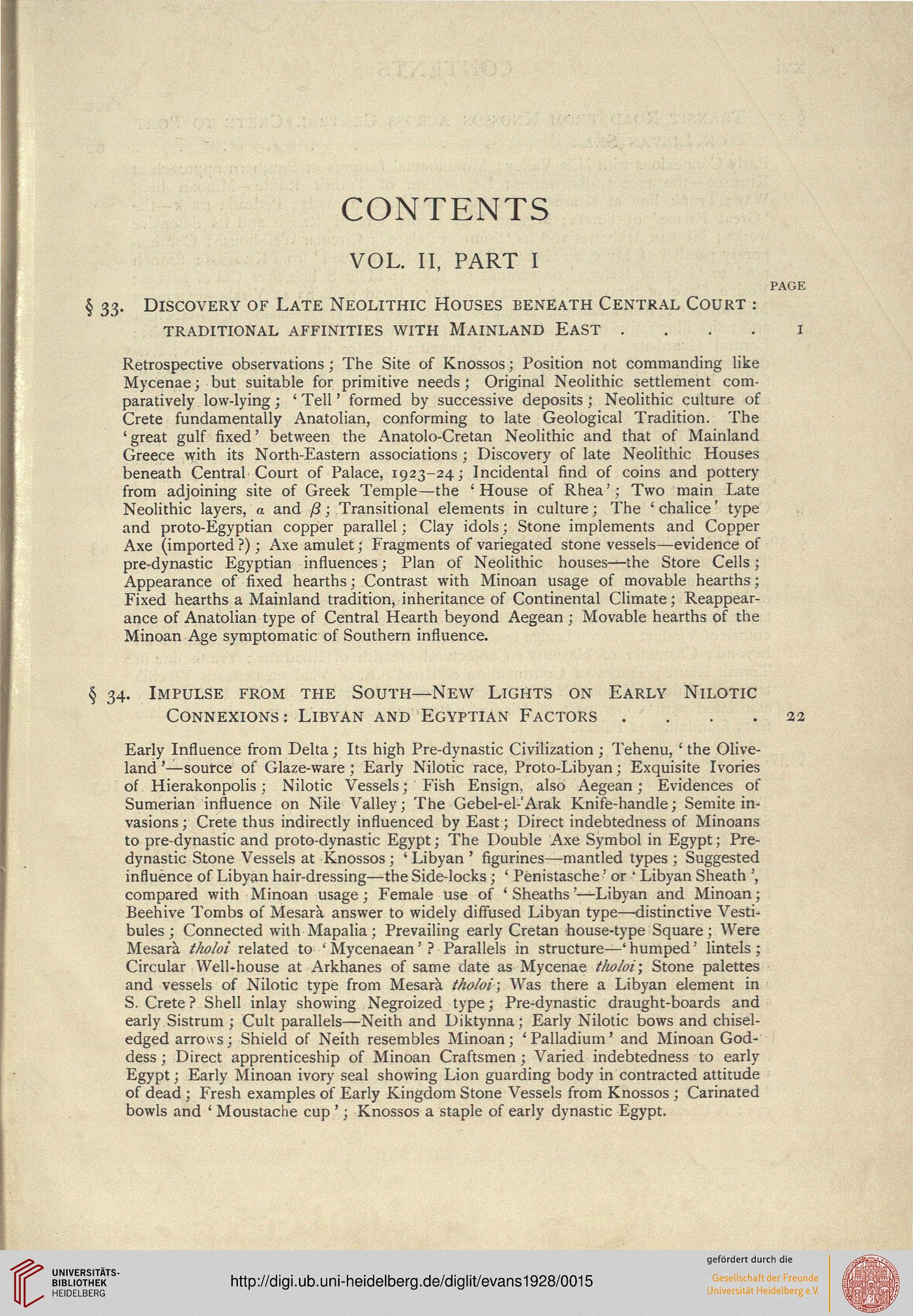CONTENTS
VOL. II, PART I
PAGE
§ 33. Discovery of Late Neolithic Houses beneath Central Court :
traditional affinities with mainland east .... i
Retrospective observations; The Site of Knossos; Position not commanding like
Mycenae; but suitable for primitive needs; Original Neolithic settlement com-
paratively low-lying; ' Tell' formed by successive deposits ; Neolithic culture of
Crete fundamentally Anatolian, conforming to late Geological Tradition. The
' great gulf fixed' between the Anatolo-Cretan Neolithic and that of Mainland
Greece with its North-Eastern associations ; Discovery of late Neolithic Houses
beneath Central Court of Palace, 1923-24; Incidental find of coins and pottery
from adjoining site of Greek Temple—the 'House of Rhea'; Two main Late
Neolithic layers, a and /3; Transitional elements in culture; The ' chalice' type
and proto-Egyptian copper parallel; Clay idols; Stone implements and Copper
Axe (imported ?) ; Axe amulet; Fragments of variegated stone vessels—evidence of
pre-dynastic Egyptian influences; Plan of Neolithic houses—the Store Cells;
Appearance of fixed hearths; Contrast with Minoan usage of movable hearths;
Fixed hearths a Mainland tradition, inheritance of Continental Climate; Reappear-
ance of Anatolian type of Central Hearth beyond Aegean; Movable hearths of the
Minoan Age symptomatic of Southern influence.
§ 34. Impulse from the South—New Lights on Early Nilotic
Connexions: Libyan and Egyptian Factors .... 22
Early Influence from Delta ; Its high Pre-dynastic Civilization ; Tehenu, ' the Olive-
land '—source of Glaze-ware; Early Nilotic race, Proto-Libyan; Exquisite Ivories
of Hierakonpolis ; Nilotic Vessels; Fish Ensign, also Aegean; Evidences of
Sumerian influence on Nile Valley; The Gebel-el-'Arak Knife-handle; Semite in-
vasions ; Crete thus indirectly influenced by East; Direct indebtedness of Minoans
to pre-dynastic and proto-dynastic Egypt; The Double Axe Symbol in Egypt; Pre-
dynastic Stone Vessels at Knossos ; ' Libyan ' figurines—mantled types ; Suggested
influence of Libyan hair-dressing—the Side-locks; ' Penistasche' or ■' Libyan Sheath ',
compared with Minoan usage ; Female use of ' Sheaths'—Libyan and Minoan;
Beehive Tombs of Mesara answer to widely diffused Libyan type—distinctive Vesti-
bules ; Connected with Mapalia; Prevailing early Cretan house-type Square; Were
Mesara tholoi related to 'Mycenaean' ? Parallels in structure—'humped' lintels;
Circular Well-house at Arkhanes of same date as Mycenae tholoi; Stone palettes
and vessels of Nilotic type from Mesara tholoi; Was there a Libyan element in
S. Crete ? Shell inlay showing Negroized type; Pre-dynastic draught-boards and
early Sistrum ; Cult parallels—Neith and Diktynna; Early Nilotic bows and chisel-
edged arrows; Shield of Neith resembles Minoan; 'Palladium' and Minoan God-
dess ; Direct apprenticeship of Minoan Craftsmen ; Varied indebtedness to early
Egypt; Early Minoan ivory seal showing Lion guarding body in contracted attitude
of dead ; Fresh examples of Early Kingdom Stone Vessels from Knossos ; Carinated
bowls and ' Moustache cup '; Knossos a staple of early dynastic Egypt.
VOL. II, PART I
PAGE
§ 33. Discovery of Late Neolithic Houses beneath Central Court :
traditional affinities with mainland east .... i
Retrospective observations; The Site of Knossos; Position not commanding like
Mycenae; but suitable for primitive needs; Original Neolithic settlement com-
paratively low-lying; ' Tell' formed by successive deposits ; Neolithic culture of
Crete fundamentally Anatolian, conforming to late Geological Tradition. The
' great gulf fixed' between the Anatolo-Cretan Neolithic and that of Mainland
Greece with its North-Eastern associations ; Discovery of late Neolithic Houses
beneath Central Court of Palace, 1923-24; Incidental find of coins and pottery
from adjoining site of Greek Temple—the 'House of Rhea'; Two main Late
Neolithic layers, a and /3; Transitional elements in culture; The ' chalice' type
and proto-Egyptian copper parallel; Clay idols; Stone implements and Copper
Axe (imported ?) ; Axe amulet; Fragments of variegated stone vessels—evidence of
pre-dynastic Egyptian influences; Plan of Neolithic houses—the Store Cells;
Appearance of fixed hearths; Contrast with Minoan usage of movable hearths;
Fixed hearths a Mainland tradition, inheritance of Continental Climate; Reappear-
ance of Anatolian type of Central Hearth beyond Aegean; Movable hearths of the
Minoan Age symptomatic of Southern influence.
§ 34. Impulse from the South—New Lights on Early Nilotic
Connexions: Libyan and Egyptian Factors .... 22
Early Influence from Delta ; Its high Pre-dynastic Civilization ; Tehenu, ' the Olive-
land '—source of Glaze-ware; Early Nilotic race, Proto-Libyan; Exquisite Ivories
of Hierakonpolis ; Nilotic Vessels; Fish Ensign, also Aegean; Evidences of
Sumerian influence on Nile Valley; The Gebel-el-'Arak Knife-handle; Semite in-
vasions ; Crete thus indirectly influenced by East; Direct indebtedness of Minoans
to pre-dynastic and proto-dynastic Egypt; The Double Axe Symbol in Egypt; Pre-
dynastic Stone Vessels at Knossos ; ' Libyan ' figurines—mantled types ; Suggested
influence of Libyan hair-dressing—the Side-locks; ' Penistasche' or ■' Libyan Sheath ',
compared with Minoan usage ; Female use of ' Sheaths'—Libyan and Minoan;
Beehive Tombs of Mesara answer to widely diffused Libyan type—distinctive Vesti-
bules ; Connected with Mapalia; Prevailing early Cretan house-type Square; Were
Mesara tholoi related to 'Mycenaean' ? Parallels in structure—'humped' lintels;
Circular Well-house at Arkhanes of same date as Mycenae tholoi; Stone palettes
and vessels of Nilotic type from Mesara tholoi; Was there a Libyan element in
S. Crete ? Shell inlay showing Negroized type; Pre-dynastic draught-boards and
early Sistrum ; Cult parallels—Neith and Diktynna; Early Nilotic bows and chisel-
edged arrows; Shield of Neith resembles Minoan; 'Palladium' and Minoan God-
dess ; Direct apprenticeship of Minoan Craftsmen ; Varied indebtedness to early
Egypt; Early Minoan ivory seal showing Lion guarding body in contracted attitude
of dead ; Fresh examples of Early Kingdom Stone Vessels from Knossos ; Carinated
bowls and ' Moustache cup '; Knossos a staple of early dynastic Egypt.





